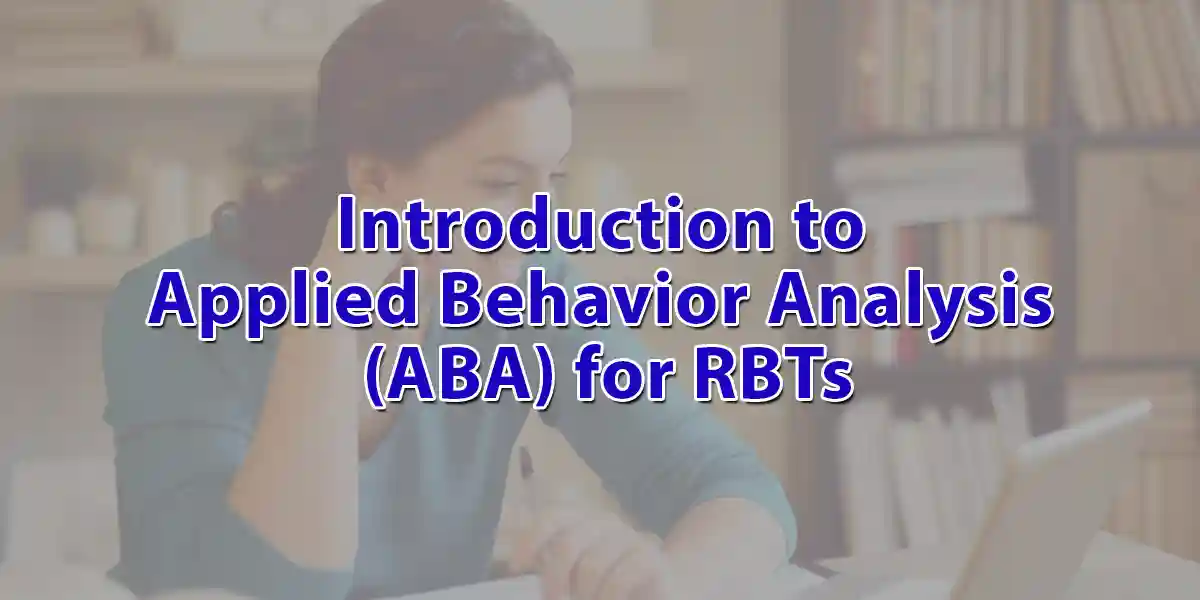What Is Applied Behavior Analysis (ABA)?
Applied Behavior Analysis, or ABA, is a scientific approach that helps us understand and improve human behavior. It focuses on identifying behaviors that can be observed and measured, then using research-based strategies to change them. The goal is simple: improve socially significant behaviors like communication, self-help, and social interaction so individuals can thrive.
ABA doesn’t rely on guesswork. Instead, it uses data and structured observation to make decisions. Whether someone is learning to tie their shoes or reducing disruptive outbursts, ABA breaks behaviors down into manageable steps, tracks progress, and makes changes when necessary.
For RBTs, ABA is the framework you’ll use every single day. It guides your sessions, your interventions, and even how you write your notes. Every decision you make in a session is rooted in the ABA model.
Why ABA Matters in Behavior Therapy
So, why does ABA matter? The effectiveness of ABA is evident across various populations. ABA has been especially effective for children with autism, but it’s also used in education, mental health, addiction treatment, and organizational behavior management.
What makes ABA powerful is its adaptability. Whether you’re helping someone learn daily routines or manage anxiety-related behaviors, ABA principles give you a toolbox to create real, lasting change.
As an RBT, your job is to apply this framework with care and precision. You’ll help create learning environments where progress is constant and setbacks become opportunities for adaptation. ABA is not a universally applicable solution. It’s tailored to every client, and you play a key role in making that customization happen.
The Core Principles of ABA
ABA rests on several core principles that shape how we approach behavior. These aren’t just theories—they’re the backbone of everything you’ll do as an RBT.
- Reinforcement – This is all about consequences that increase the likelihood of a behavior happening again. Reinforcers can be praise, access to a toy, or even a break from a task.
- Prompting and Fading – Prompts help clients perform a behavior. Fading gradually reduces help so independence grows.
- Shaping – Reinforcing small steps that gradually lead to a more complex behavior.
- Generalization – Ensuring skills learned in one setting transfer to other environments and people.
- Extinction – When a behavior that was once reinforced no longer receives reinforcement, it starts to decrease.
Each of these principles shows up in everyday RBT work, from teaching a child to request juice to helping a teen manage transitions.
How ABA Is Used in Real-Life Settings
ABA isn’t confined to therapy rooms. It happens at school, home, daycare, and community centers. For example:
- A young learner may use picture exchange communication to request snacks at home.
- A teenager with anxiety may learn coping strategies through role play at a clinic.
- An adult with developmental disabilities may work on job skills at a community center.
As an RBT, you’ll be implementing ABA procedures wherever your client needs support. That could mean running discrete trial training at a table, embedding learning into playtime, or prompting functional communication during snack time.
What matters most is consistency. You’ll be one of the most frequent providers in your client’s life, so how you carry out ABA strategies truly shapes their progress.
The Role of the RBT in ABA Services
The RBT is the engine of ABA implementation. You’re the one directly working with the client, running programs, collecting data, and making sure everything is implemented as written by the BCBA.
Your responsibilities include:
- Delivering skill acquisition and behavior reduction programs
- Recording accurate data during sessions
- Using reinforcement schedules and prompting procedures correctly
- Reporting progress or concerns to your supervisor
- Maintaining ethical and professional boundaries
You won’t create treatment plans or diagnose, but you’ll be the eyes, ears, and hands that bring those plans to life.
The more you understand how your actions connect to behavior change, the more effective you’ll be. Practicing with tools like RBT Practice Exam 1 and RBT Practice Exam 2 helps strengthen your understanding of your day-to-day tasks.
How ABA Supports Positive Behavior Change
ABA’s most important contribution is teaching what to do instead of a difficult behavior. Rather than just trying to “stop” something, ABA focuses on building up more useful alternatives.
For instance, if a child throws objects to avoid a task, you might teach them to request a break verbally. If someone screams for attention, you teach them to ask or gesture appropriately.
These are called replacement behaviors, and they’re reinforced just like any skill you’d teach.
What makes this approach powerful is that it treats behavior as communication. ABA assumes there’s always a reason behind what someone is doing, and it’s your job to figure out what that reason is and address it effectively.
Data Collection and Its Importance in ABA
Everything you do as an RBT relies on data. Why? Data provides valuable insights. It shows if a skill is being mastered, if a behavior is improving, or if something isn’t working and needs to be changed.
You’ll collect data in many formats:
- Frequency – How often something happens
- Duration – How long it lasts
- Latency – How long it takes to respond after a prompt
- Trial-by-trial – A record of each attempt and result
Your data needs to be accurate, objective, and timely. What you record gets reviewed by supervisors and may be shared with parents, insurance companies, or legal professionals.
RBT Practice Exam 3 is a great tool to test your understanding of measurement and data collection—key components of Unit A: Measurement and Unit E: Documentation.
Skill Acquisition vs. Behavior Reduction in ABA
ABA programs generally have two components: Skill Acquisition Plans (SAPs) and Behavior Intervention Plans (BIPs).
- SAPs help build new skills, like language, play, social skills, hygiene, or academics.
- BIPs help reduce behaviors that interfere with learning, like aggression or noncompliance.
You might teach a learner to request snacks (SAP) while also using extinction to reduce tantrums (BIP). These strategies often complement each other. Teaching a replacement behavior supports the reduction of an unwanted one.
Being able to follow these plans precisely is crucial, and you’ll need to understand both Unit C: Skill Acquisition and Unit D: Behavior Reduction thoroughly.
Ethics and Professional Boundaries in ABA Practice
Working with vulnerable populations means adhering to strict ethical guidelines. That includes:
- Maintaining client confidentiality
- Following the treatment plan exactly
- Respecting cultural differences
- Avoiding dual relationships (e.g., socializing outside of work)
- Reporting concerns to supervisors
Ethics is not just about rules—it’s about ensuring your clients are safe, respected, and receive high-quality care.
Unit F: Professional Conduct outlines the dos and don’ts of RBT behavior, and RBT Practice Exam 4 offers scenario-based questions that help you apply those principles in real-world settings.
Getting Started as an RBT in the ABA Field
Becoming an RBT is more than passing an exam. It’s about learning to think like a behavior technician, follow plans consistently, and engage clients with patience and positivity.
Here’s how to start strong:
- Learn the Task List – Study all 6 Units (A–F) thoroughly.
- Practice Scenario-Based Questions – Use tools like RBT Practice Exam 5 to strengthen application skills.
- Observe Experienced RBTs – If possible, shadow others to see ABA in action.
- Ask for Feedback – Be open to supervision—it’s how you grow.
- Stay Curious – Keep learning. Attend webinars, read books, and explore new ABA topics.
Once you understand how behavior works and how your role shapes it, you’ll be able to support meaningful change for every client you serve.

